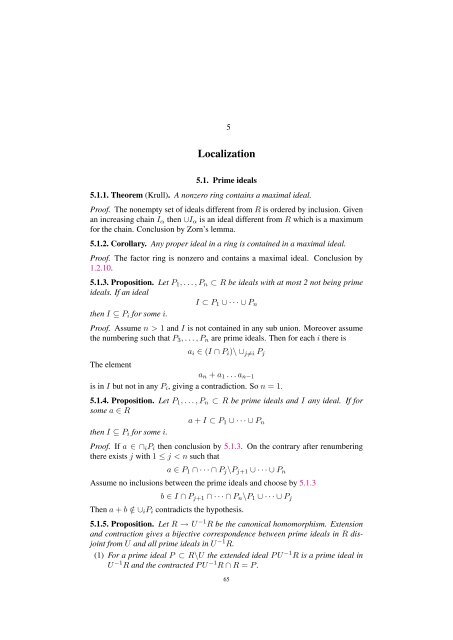Commutative algebra - Department of Mathematical Sciences - old ...
Commutative algebra - Department of Mathematical Sciences - old ...
Commutative algebra - Department of Mathematical Sciences - old ...
Create successful ePaper yourself
Turn your PDF publications into a flip-book with our unique Google optimized e-Paper software.
5<br />
Localization<br />
5.1. Prime ideals<br />
5.1.1. Theorem (Krull). A nonzero ring contains a maximal ideal.<br />
Pro<strong>of</strong>. The nonempty set <strong>of</strong> ideals different from R is ordered by inclusion. Given<br />
an increasing chain Iα then ∪Iα is an ideal different from R which is a maximum<br />
for the chain. Conclusion by Zorn’s lemma.<br />
5.1.2. Corollary. Any proper ideal in a ring is contained in a maximal ideal.<br />
Pro<strong>of</strong>. The factor ring is nonzero and contains a maximal ideal. Conclusion by<br />
1.2.10.<br />
5.1.3. Proposition. Let P1, . . . , Pn ⊂ R be ideals with at most 2 not being prime<br />
ideals. If an ideal<br />
I ⊂ P1 ∪ · · · ∪ Pn<br />
then I ⊆ Pi for some i.<br />
Pro<strong>of</strong>. Assume n > 1 and I is not contained in any sub union. Moreover assume<br />
the numbering such that P3, . . . , Pn are prime ideals. Then for each i there is<br />
The element<br />
ai ∈ (I ∩ Pi)\ ∪j=i Pj<br />
an + a1 . . . an−1<br />
is in I but not in any Pi, giving a contradiction. So n = 1.<br />
5.1.4. Proposition. Let P1, . . . , Pn ⊂ R be prime ideals and I any ideal. If for<br />
some a ∈ R<br />
a + I ⊂ P1 ∪ · · · ∪ Pn<br />
then I ⊆ Pi for some i.<br />
Pro<strong>of</strong>. If a ∈ ∩iPi then conclusion by 5.1.3. On the contrary after renumbering<br />
there exists j with 1 ≤ j < n such that<br />
a ∈ P1 ∩ · · · ∩ Pj\Pj+1 ∪ · · · ∪ Pn<br />
Assume no inclusions between the prime ideals and choose by 5.1.3<br />
b ∈ I ∩ Pj+1 ∩ · · · ∩ Pn\P1 ∪ · · · ∪ Pj<br />
Then a + b /∈ ∪iPi contradicts the hypothesis.<br />
5.1.5. Proposition. Let R → U −1 R be the canonical homomorphism. Extension<br />
and contraction gives a bijective correspondence between prime ideals in R disjoint<br />
from U and all prime ideals in U −1 R.<br />
(1) For a prime ideal P ⊂ R\U the extended ideal P U −1 R is a prime ideal in<br />
U −1 R and the contracted P U −1 R ∩ R = P .<br />
65
















